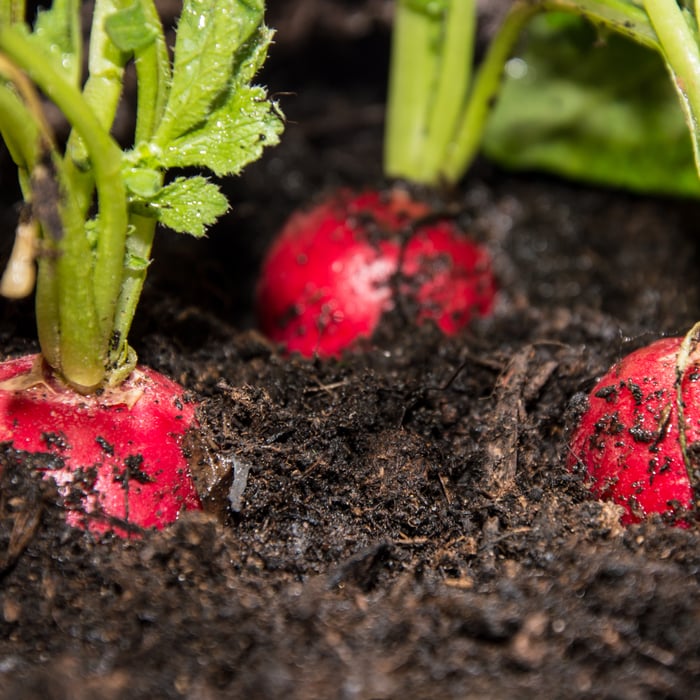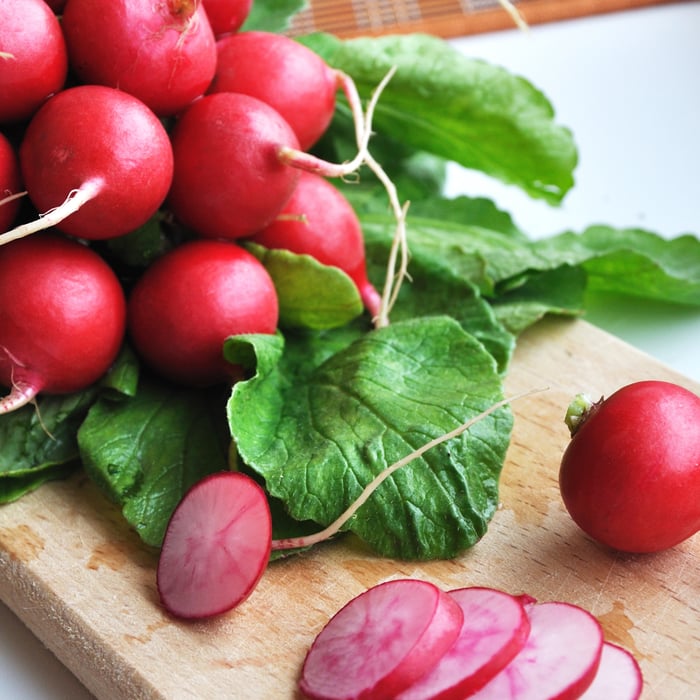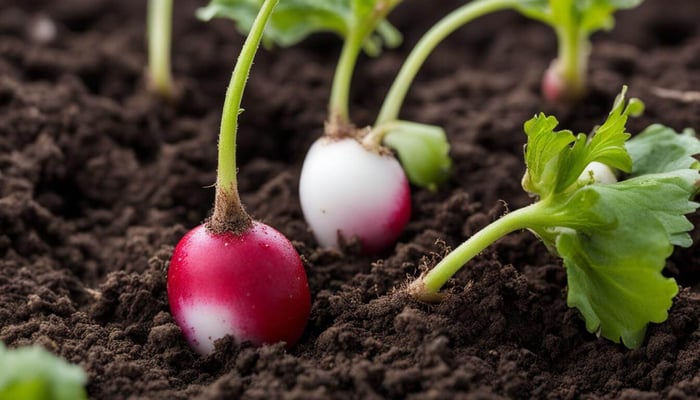Growing your own radishes is fun. You can grow wide varieties you cannot purchase in the store. Heirloom radishes are fun to grow. They mature rapidly and would be fun to grow with kids. Let's learn how to grow radishes from seeds and see how easy it is!
Growing Radish from Seed: Planting Depth
Radishes are one of the easiest vegetables to grow from seed, making them a popular choice for beginner gardeners. Radish seeds quickly germinate and mature and can be produced in various soil types and containers. One crucial factor to consider when planting radish seeds is the depth at which they should be sown. Let's discuss the optimal planting depth for radish seeds and why it matters when talking about how to grow radishes from seeds.
What is planting depth?
Planting depth refers to the distance between the soil's surface and the top of the seed when it is sown. The depth at which seeds are planted can impact their ability to germinate and grow properly. If roots are planted too shallow, they may not receive enough moisture or protection from the sun. If they are planted too deep, they may struggle to push through the soil and reach the surface.
Why does planting depth matter for radish seeds?
Radish seeds are tiny and should be planted relatively shallowly. A good rule of thumb is to plant radish seeds at a depth of ½ inch to 1 inch deep. Planting at the correct depth ensures the source has enough moisture and access to sunlight to germinate and grow properly. It also allows the seedling to push through the soil and quickly emerge at the surface.
If planted too shallowly, radish seeds may dry out quickly and struggle to establish themselves. They may also be more susceptible to pests and diseases damaging the fragile seedlings. On the other hand, if radish seeds are planted too deep, they may struggle to break through the soil and emerge as healthy seedlings. This can result in stunted growth, uneven germination, and poor crop yield.
Radish Seed Assortment | 5 Variety Pack
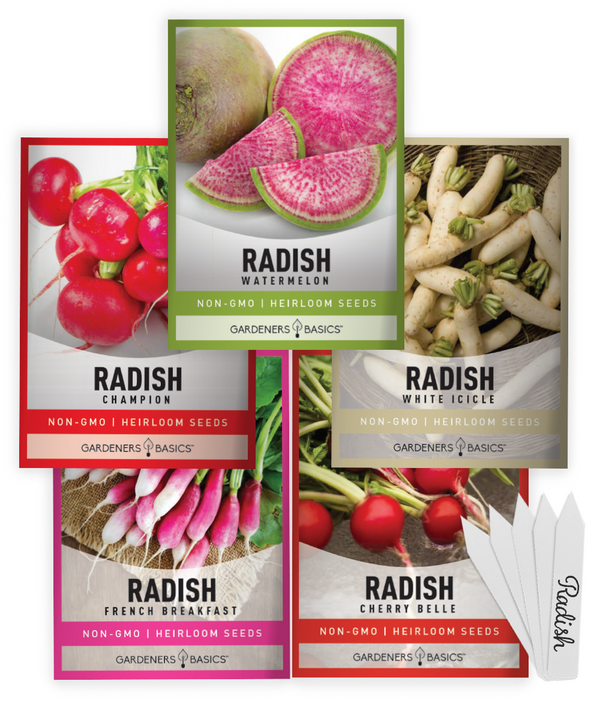
$9.95
5 Radish Seeds Variety Pack – Heirloom, Non-GMO, Open-Pollinated, Non-Hybrid Bring diversity, flavor, and color to your garden with our 5 Radish Seeds Variety Pack. This exclusive assortment includes five unique radish varieties that are perfect for every season and… read more
How to determine the correct planting depth for radish seeds?
To determine the correct planting depth for your radish seeds, consider the size and shape of the source. Radish seeds are small and round and should be planted relatively shallowly. A general rule of thumb is to plant seeds at a depth of ½ to 1 inch deep.
If you are planting radish seeds in a garden bed, use a garden trowel to create a shallow trench. The trench should be no more than 1 inch deep, and the soil should be loosened to a depth of about 2 inches. Once the track is prepared, sow the seeds thinly and cover them with a thin layer of soil. Firm the soil gently over the seeds to ensure good seed-to-soil contact.
The process is similar if you are planting radish seeds in a container. Fill the container with a good quality potting mix, leaving about ½ inch of space at the top. Sow the seeds thinly and cover them with a thin layer of the potting mixture. Water gently to ensure good seed-to-soil contact.
Planting depth is an essential factor to consider when growing radishes from seed. Ensuring that seeds are produced at the correct depth can help promote healthy germination and growth, ultimately leading to a successful harvest. When planting radish seeds, aim to sow them at a depth of ½ inch to 1 inch deep, depending on the size and shape of the source. Prepare the soil properly and sow the seeds thinly to ensure good seed-to-soil contact.
Other factors to consider when growing radishes from seed include soil quality, watering frequency, and pest control. Radishes prefer well-drained soil that is rich in organic matter. They also require regular watering, especially during hot and dry periods. Be sure to monitor your radish plants for signs of pests and diseases, and take action promptly to prevent damage to the crop.
In addition to growing radishes in a traditional garden bed, they can also be grown in containers, making them an excellent choice for those with limited space or poor-quality soil. When growing radishes in containers, choose a container at least 6 inches deep with good drainage. Fill the container with a good quality potting mix, and follow the same planting depth guidelines as you would for a garden bed.
Growing radish from seed is a simple and rewarding process. Attention to planting depth and other factors ensures your radish crop grows strong and healthy. Whether you are a seasoned gardener or a beginner, radishes are an excellent choice for your vegetable garden. Happy planting!
Growing Radish from Seed: Germination
Germination is the process by which a seed begins to grow and develop into a plant. For radish seeds, the germination process is relatively quick and straightforward, making them a popular choice for beginner gardeners. We need to talk about the germination process for radish seeds and the factors that can impact it when learning how to grow radishes from seeds.
What is germination?
Germination is the process by which a seed begins to grow and develop into a plant. The process, when started, absorbs water, which triggers the release of enzymes that break down stored food inside the kernel. As the stored food is broken down, the embryo seed grows and develops roots, stems, and leaves.
How long does it take for radish seeds to germinate?
Radish seeds typically germinate within 3 to 10 days of being planted. The exact time frame will depend on several factors, including soil temperature, moisture level, and planting depth.
Soil temperature: Radish seeds require a soil temperature of at least 45°F (7°C) to germinate. However, they in growth more quickly if the soil temperature is between 55°F and 75°F (13°C to 24°C). If the soil temperature is too low, the seeds may take longer or not germinate.
Moisture level: Radish seeds require consistent moisture to germinate. The soil should be kept moist but not waterlogged. If the soil is too dry, root seeds may not absorb enough water to trigger germination. If the soil is too wet, the roots may rot before they have a chance to germinate.
Planting depth: Radish seeds should be planted relatively shallowly, at a depth of ½ inch to 1 inch. They may struggle to push through the soil and emerge as healthy seedlings if buried too deeply.
Cherry Belle Radish Seeds
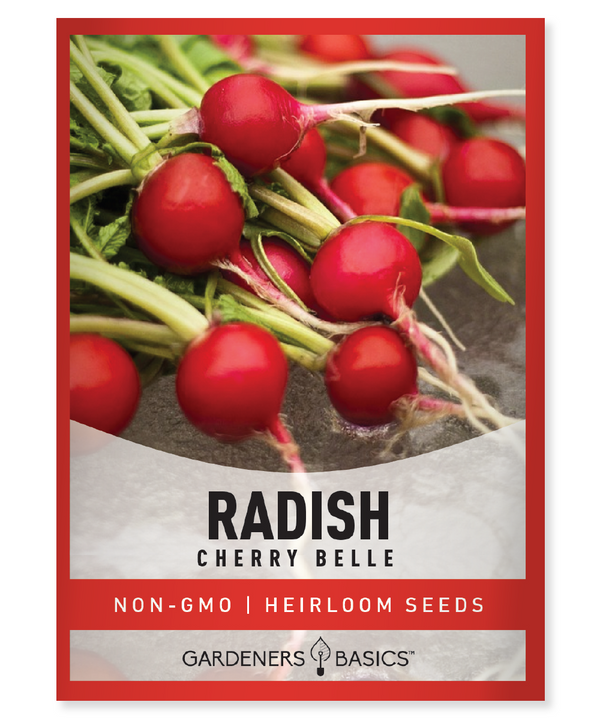
$2.49
Cherry Belle Radish Seeds - Heirloom, Non-GMO, Non-Hybrid, Open-Pollinated Grow vibrant and delicious Cherry Belle Radishes in your garden with our premium heirloom, non-GMO, non-hybrid, open-pollinated seeds! These fast-growing radishes are a must-have for home gardeners looking to enjoy crisp,… read more
How do plants radish seeds for optimal germination?
To plant radish seeds for optimal germination, follow these steps:
- Prepare the soil: Radish seeds prefer well-drained soil rich in organic matter. Use a garden fork or tiller to loosen the dirt to a depth of about 6 inches. Remove any weeds or rocks from the ground.
- Plant the seeds: Plant radish seeds at a depth of ½ inch to 1 inch, depending on the size and shape of the source. Sow the seeds thinly to prevent overcrowding, and cover them with a thin layer of soil. Firm the soil gently over the seeds to ensure good seed-to-soil contact.
- Water the soil: Water the soil immediately after planting to ensure good seed-to-soil contact. Water regularly to keep the soil moist but not waterlogged.
- Maintain optimal conditions: Keep the soil temperature between 55°F and 75°F (13°C to 24°C) and ensure that the soil is consistently moist. Be sure to thin out any overcrowded seedlings to prevent competition for resources.
What are some common problems with radish seed germination?
Despite their ease of growth, radish seeds can sometimes encounter problems with germination. Some common issues include:
- Poor soil quality: Radish seeds require well-drained soil rich in organic matter. If the ground is too compacted or lacks nutrients, roots may struggle to germinate or may not germinate at all.
- Inconsistent moisture: Radish seeds require consistent moisture to germinate. If the soil is too dry or too wet, the sources may not be able to absorb enough water to trigger germination.
- Pests and diseases: Pests and diseases can also impact the germination process of radish seeds. Some common problems that can damage radish seeds and seedlings include flea beetles, cutworms, and root maggots. These pests can feed on the seedlings and cause significant damage before they have a chance to establish themselves.
Diseases such as damping off, caused by fungal pathogens, can also impact the germination of radish seeds. Damping off can cause the seedlings to wilt and die, often before they emerge from the soil.
It is essential to take preventative measures to prevent pest and disease problems from impacting the germination of radish seeds. This can include using row covers to prevent pests from accessing the seedlings, rotating crops to prevent the buildup of soil-borne diseases, and using a high-quality potting mix if growing in containers.
Germination is an essential process in the growth of radish plants. By following the proper planting techniques and ensuring optimal soil conditions and moisture levels, you can help to ensure successful germination and establishment of your radish crop. Be sure to monitor your plants for signs of pest or disease problems and take prompt action to prevent damage to your crop. You can enjoy a bountiful harvest of fresh radishes from your garden with a bit of care and attention.
How to Grow Radishes From Seeds: Watering
Watering is a critical aspect of growing radishes from seed. Adequate water is necessary for germination, growth, and plant development. Watering for radish plants, how often to water, and some tips for watering effectively.
Why is watering important for radish plants?
Radish plants require consistent moisture to grow properly. Inadequate or inconsistent watering can result in stunted growth, poor-quality roots, and uneven germination. Proper watering is essential during the early stages of development when the plants are establishing themselves.
How often should I water radish seeds?
Radish seeds require consistent moisture to germinate. Water the soil immediately after planting to ensure good seed-to-soil contact. After the seeds have germinated, continue to water the soil regularly to keep it moist but not waterlogged.
Watering frequency will depend on several factors, including the weather, soil type, and container size. Radish plants should generally be watered every 2-3 days or more frequently during hot and dry periods. Monitor the soil moisture level regularly and adjust your watering schedule accordingly.
French Breakfast Radish Seeds

$2.49
French Breakfast Radish Seeds – Heirloom, Non-GMO, Non-Hybrid, Open-Pollinated Grow the deliciously crisp and mildly spicy French Breakfast Radish, a timeless heirloom favorite known for its unique oblong shape and vibrant red skin with a white tip. Perfect for beginner… read more
How much water do radish plants need?
Radish plants require about 1 inch of water per week from rainfall or irrigation. The water they need may vary depending on the weather and soil conditions. It is essential to ensure the soil is consistently moist but not waterlogged.
To determine if your plants are receiving enough water, dig about 1-2 inches into the soil. If the ground feels dry, it is time to water. If the ground soil feels wet, wait a day or two before checking again.
What is the best time of day to water radish plants?
The best time of day to water radish plants is in the morning. This allows the leaves to dry quickly and reduces the risk of disease. Watering in the evening or at night can lead to prolonged moisture on the leaves, encouraging the growth of fungal infections.
Aim to water in the early afternoon if you cannot drown in the morning. Avoid watering during the hottest part of the day, as the water may evaporate before it can penetrate the soil.
How should I water radish plants?
When watering radish plants, aim to water the soil directly rather than the leaves. This helps to reduce the risk of disease and ensures that the water reaches the roots where it is needed most.
If you are growing radish plants in a garden bed, use a watering can or hose with a nozzle to water the soil directly. Water the soil around the base of the plant, taking care not to splash water onto the leaves.
If you are growing radish plants in a container, water the soil directly using a watering can or hose with a nozzle. Be sure to water until the excess water drains out of the bottom of the container.
Watering is a critical aspect of growing radishes from seed. Adequate water is necessary for the plant's germination, growth, and development. Radish plants require consistent moisture to grow properly, and it is essential to water them regularly to ensure the soil is consistently moist but not waterlogged. Be sure to water in the morning, water the ground directly, and adjust your watering schedule based on weather conditions and soil moisture levels. Proper watering allows you to enjoy a bountiful harvest of fresh radishes from your garden.
Growing Radish from Seed: Thinning
Thinning is an essential step in growing radishes from seed. As radish seeds germinate, they often produce more seedlings than can be sustained by the available resources. Thinning involves removing some seedlings to ensure that the remaining plants have enough space, nutrients, and water to grow and develop properlyThisis article will discuss why thinning is essential when to thin and how to thin radish seedlings effectively.
Why is thinning important for radish seedlings?
Thinning is essential for radish seedlings because it allows the remaining plants to grow and develop properly. If too many seedlings are allowed to grow in a small area, they will compete for resources such as nutrients, water, and sunlight. This can result in stunted growth, poor-quality roots, and uneven germination.
Thinning also helps to prevent overcrowding, which can create a humid microclimate that encourages the growth of fungal diseases such as damping off. By thinning radish seedlings, you can create a healthy growing environment that promotes strong and healthy plants.
When should I thin radish seedlings?
Radish seedlings should be thinned after developing their first set of true leaves. True leaves are the second set of leaves to appear after the seed leaves, and they are usually more extensive and more defined than the seed leaves.
Thinning should be done before the radish plants reach 2 inches in height. If the seedlings are allowed to grow larger than this before thinning, they may be more difficult to remove without damaging the roots of the remaining seedlings.
Vegetable Seed Vault Kit | 35 Variety Pack

$29.95
$49.95
Ultimate Survival Seed Vault: 16,000+ Non-GMO Heirloom Vegetable Seeds for Emergency Preparedness Introducing the Seed Vault Kit, your all-in-one solution for emergency preparedness and sustainable gardening. This premium seed kit contains over 16,000 non-GMO, Heirloom, Non-Hybrid, and Open Pollinated seeds,… read more
How do I thin radish seedlings effectively?
To thin radish seedlings effectively, follow these steps:
- Prepare the soil: Before thinning, water the soil thoroughly to ensure it is moist and easy to work with. Use a garden trowel or small scissors to remove the unwanted seedlings, taking care not to damage the roots of the remaining seedlings.
- Identify the seedlings to remove: Look for seedlings that are growing too close together or appear weak or stunted. Aim to remove the smallest and weakest seedlings, leaving the largest and healthiest ones to thrive.
- Space the remaining seedlings: Space the remaining seedlings evenly, leaving a distance of about 2 inches between each plant. This will allow each plant to receive adequate resources and grow to its full potential.
- Remove the unwanted seedlings: Gently pull or cut the unwanted seedlings at ground level. Take care not to disturb the roots of the remaining seedlings.
- Dispose of the unwanted seedlings: Dispose of them by composting or placing them in the trash.
Thinning is an essential step in growing radishes from seed. Removing some seedlings can create a healthy growing environment promoting strong and healthy plants. Thin radish seedlings when they have developed their first set of true leaves and aim to space the remaining seedlings evenly to allow each plant to receive adequate resources. Proper thinning will enable you to enjoy a bountiful harvest of fresh radishes from your garden.
Growing Radish from Seed: Companion Planting
Companion planting is a gardening technique that involves planting different crops together to benefit each other. When it comes to growing radish from seed, companion planting can help to improve soil health, control pests, and enhance the overall yield of your garden. Let's explore the benefits of companion planting for radish plants, some of the best companion plants to grow with radishes, and how to start companion planting.
Benefits of Companion Planting for Radish Plants
Companion planting can provide several benefits for radish plants, including:
- Improving soil health: Some companion plants can help improve soil health by adding nutrients and organic matter. For example, planting legumes such as beans or peas can help fix nitrogen in the soil, benefiting radish plants.
- Controlling pests: Some companion plants can help to repel pests or attract beneficial insects that can control pests. For example, planting marigolds or nasturtiums can help to repel pests such as aphids and whiteflies.
- Enhancing yield: Some companion plants can help improve or enhance your garden's overall harvest enhance your garden's comprehensive work, pollinators, or provide shade. For example, sunflowers can shade radish plants during hot periods and attract pollinators like bees.
Best Companion Plants to Grow with Radish
Some of the best companion plants to grow with radish include:
- Lettuce: Lettuce is a great companion plant for radish because it has shallow roots and can help to shade the soil and retain moisture. Lettuce proliferates and can be harvested before it competes with radish plants for resources.
- Peas: Peas are a legume that can help fix nitrogen in the soil, benefiting radish plants. They also have shallow roots that can help shade the soil and retain moisture.
- Beans: Like peas, beans are legumes that can help fix soil nitrogen. They also have deep roots that can help to break up compacted soil and improve soil structure.
- Nasturtiums: Nasturtiums are a great companion plant for radish because they can repel pests such as aphids and whiteflies. They also have shallow roots that can help shade the soil and retain moisture.
- Marigolds are another companion plant that can repel pests such as aphids and whiteflies. They also have a deep taproot that can help to break up compacted soil.
Getting Started with Companion Planting
To get started with companion planting for radish plants, follow these steps:
- Choose your companion plants: Choose companion plants that benefit radish plants by improving soil health, controlling pests, or enhancing yield. Consider the growing requirements of each plant to ensure that they will thrive in the same growing conditions.
- Plan your garden layout: Ensure the companion plants are spaced appropriately and will not compete with the radish plants for resources. Consider using intercropping techniques, such as planting lettuce between rows of radish plants, to maximize the use of space.
- Plant your companion plants: Plant your companion plants alongside your radish plants, following proper planting depth and spacing guidelines.
- Monitor your garden: Monitor your garden regularly to ensure that the companion plants are not competing with the radish plants for resources or attracting pests.
Companion planting is a great way to improve your garden's overall health and yield when growing radishes from seed. Choosing the right companion plants can help improve soil health, control pests, and enhance yield. Lettuce, peas, beans, nasturtiums, and marigolds are all great companion plants to grow with radishes. Plann, your garden layout carefully, plant your companion plants at the appropriate depth and spacing and monitor your garden regularly for any issues. You can enjoy a healthy and thriving garden and a bountiful harvest of delicious, fresh radishes with proper companion planting techniques.
Growing Radish from Seed: Fertilizer
Fertilizer is an essential aspect of growing radishes from seed. Adequate fertilizer can help ensure healthy plant growth and development and improve the quality and yield of your radish crop.
Why is fertilizer necessary for radish plants?
Radish plants require a balance of nutrients to grow properly. Adequate fertilizer can help ensure the plants have enough nutrients to support healthy growth and development and improve the crop's quality and yield. Fertilizers can also help to improve soil health by adding organic matter and improving soil structure.
How do I choose the right fertilizer for radish plants?
When choosing a fertilizer for radish plants, it is essential to consider the nutrient needs of the plants. Radish plants require a balance of nitrogen, phosphorus, potassium, and other micronutrients such as calcium and magnesium.
A general-purpose fertilizer with a balanced NPK ratio, such as 10-10-10 or 20-20-20, is usually sufficient for radish plants. Alternatively, you can use a fertilizer formulated for root crops or vegetables.
Organic fertilizers, such as compost or manure, can also fertilize radish plants. These fertilizers provide a slow-release source of nutrients and can help improve soil health.
Radish Seed Assortment | 5 Variety Pack

$9.95
5 Radish Seeds Variety Pack – Heirloom, Non-GMO, Open-Pollinated, Non-Hybrid Bring diversity, flavor, and color to your garden with our 5 Radish Seeds Variety Pack. This exclusive assortment includes five unique radish varieties that are perfect for every season and… read more
When and how should I apply fertilizer to radish plants?
Radish plants should be fertilized at planting time and again when they reach about 4-6 inches in height. To apply fertilizer, sprinkle it evenly over the soil around the base of the plant, taking care not to get any on the leaves.
Alternatively, you can mix the fertilizer into the soil before planting. This can help to ensure that the nutrients are evenly distributed throughout the ground and are available to the plants as they grow.
Follow the manufacturer's instructions for application rates, timing, and any safety precautions.
How much fertilizer do radish plants need?
The amount of fertilizer for radish plants will depend on several factors, including the soil type, growing conditions, and the fertilizer used. Radish plants generally require about 1 pound of fertilizer per 100 square feet of garden bed.
To determine the optimal fertilizer for your radish plants, have your soil tested by a professional or use a home testing kit. This can help to identify any nutrient deficiencies or imbalances in the ground and allow you to adjust your fertilization plan accordingly.
Fertilizer is an essential aspect of growing radishes from seed. Adequate fertilizer can help ensure healthy plant growth and development and improve the quality and yield of your radish crop. Choose a balanced NPK ratio fertilizer, or use organic fertilizers such as compost or manure. Apply fertilizer at planting time and again when the plants reach 4-6 inches in height, following the manufacturer's instructions for application rates and timing. You can enjoy a healthy and bountiful harvest of fresh radishes by properly fertilizing your radish plants.
Growing Radish from Seed: Harvesting
Harvesting is an essential aspect of growing radishes from seed. Knowing when and how to harvest your radish crop can help ensure it is at its peak flavor and texture.
When are radishes ready for harvest?
Radishes are usually ready for harvest about 3-4 weeks after planting. However, the exact timing will depend on the variety of radishes and the growing conditions.
The best way to determine if your radishes are ready for harvest is to observe the size and shape of the radish bulb. Most radish varieties will develop a round or oval-shaped bulb about 1-2 inches in diameter.
When the radish bulbs have reached their mature size and shape, they will feel firm to the touch, and the skin will have a smooth, glossy appearance. The top of the radish bulb will also start to poke through the soil, indicating it is ready for harvest.
How do I harvest radishes?
To harvest your radishes, follow these steps:
- Choose a dry day: Choose a dry day to harvest your radishes. Wet soil can make it challenging to pull the radishes out of the ground and increase the risk of damage to the radish bulb.
- Loosen the soil: Loosen the dirt around the radish base with a garden fork or trowel. Be careful not to damage the radish bulb.
- Pull the radish: Grasp the top of the radish bulb and gently pull it out of the soil. If the radish is challenging to remove, use a garden fork or trowel to loosen the dirt further.
- Trim the leaves: Once the radish is harvested, trim the leaves and stems to about 1 inch from the top of the bulb. This will help to prevent moisture loss and prolong the storage life of the radish.
Tips for storing and using your radish crop
To store your radish crop, remove any dirt or debris from the bulbs and place them in a plastic bag or container with a lid. Store the radishes in the refrigerator for up to 2 weeks.
Radishes can be eaten raw or cooked and are a versatile addition to salads, sandwiches, and other dishes. They can also be pickled or fermented for a tangy and flavorful meal addition.
When using radishes in recipes, wash them thoroughly and remove any blemishes or damaged areas. The tops of radishes can also be used in recipes, such as salads or garnish.
In conclusion, harvesting is an essential aspect of growing radishes from seed. Knowing when and how to harvest your radish crop can help ensure it is at its peak flavor and texture. Harvest your radishes when the bulbs have reached their mature size and shape, and pull them gently from the soil. Store your radishes in the refrigerator for up to 2 weeks, and use them raw or cooked in various dishes. By properly harvesting and using your radish crop, you can enjoy homegrown radishes' delicious, fresh flavor.
Growing Radish from Seed: Pest Control
Pest control is an essential aspect of growing radishes from seed. Pests such as aphids, flea beetles, and root maggots can damage radish plants and reduce the quality and yield of the crop. This article will discuss common pests that affect radish plants, how to identify them, and tips for controlling them.
Common Pests that Affect Radish Plants
Aphids: Aphids are small, soft-bodied insects found on the leaves and stems of radish plants. They feed on the plant's sap and can cause stunted growth, yellowing leaves, and distorted or curled leaves.
Flea beetles: Flea beetles are small, shiny black or brown beetles that can jump like fleas. They feed on the leaves of radish plants, leaving tiny holes that can eventually cause the leaves to wither and die.
Root maggots: Root maggots are the larvae of flies that lay their eggs at the base of radish plants. They feed on the plant's roots, causing stunted growth, yellowing leaves, and wilted plants.
Seed Safe Survival Seed Kit - 35 Variety Pack
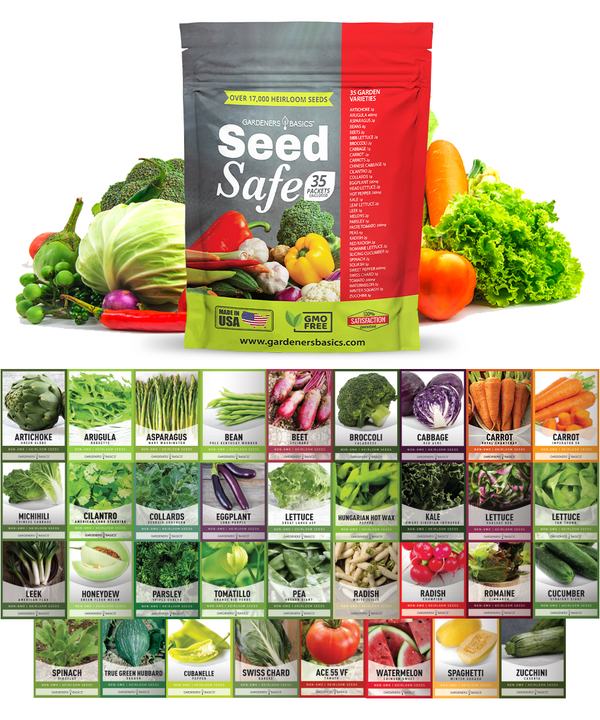
$29.95
$49.95
Seed Safe Survival Seed Kit: The Ultimate Heirloom Collection for Self-Sufficient Gardening Introducing the Seed Safe - 35 Varieties of Heirloom Vegetable, Herb, and Fruit Seeds, the ultimate solution for gardeners who want to secure a bountiful future harvest. This… read more
How to Identify Pests
To identify pests that are affecting your radish plants, look for the following signs:
- Small, soft-bodied insects on the leaves or stems of the plant (aphids)
- Small holes in the leaves (flea beetles)
- Wilting or stunted plants with yellowing leaves or brown, rotting roots (root maggots)
Tips for Controlling Pests
To control pests that are affecting your radish plants, follow these tips:
- Use row covers: Row covers can help to prevent problems from reaching your radish plants. Cover the plants with a lightweight fabric, such as insect netting, until they are established.
- Rotate crops: Rotating crops can help to prevent pests from building up in the soil. Avoid planting radishes in the exact location for more than one growing season.
- Use companion planting: Companion planting can help to repel pests and attract beneficial insects. Plant herbs such as basil or mint near your radish plants to repel aphids or plant marigolds to repel flea beetles.
- Use organic pest control methods: Organic pest control methods, such as insecticidal soap or neem oil, can help to control pests without harming beneficial insects. Follow the manufacturer's instructions for application rates and timing.
- Handpick pests: Handpicking pests such as aphids or flea beetles can effectively control their populations. Use a pair of tweezers or gloves to remove the problems from the plants.
Pest control is an essential aspect of growing radishes from seed. Common pests such as aphids, flea beetles, and root maggots can damage radish plants and reduce the quality and yield of the crop. Use row covers, rotate crops, companion planting, organic pest control methods, and handpick pests to control problems affecting your radish plants. You can enjoy a healthy and bountiful harvest of delicious, fresh radishes by properly controlling pests.
Frequently Asked Questions about How to Grow Radishes from Seeds
Q: When is the best time to plant radish seeds?
A: Radish seeds can be planted early spring or late summer for a fall harvest. They prefer cooler temperatures and can be produced when soil temperatures reach about 45°F (7°C).
Q: How deep should I plant radish seeds?
A: Radish seeds should be planted about 1/2 inch deep in well-draining soil.
Q: How much water do radish plants need?
A: Radish plants need regular watering, about 1 inch per week. However, be careful not to overwater, which can cause the roots to rot.
Q: How do I fertilize my radish plants?
A: Radish plants don't need a lot of fertilizer. A balanced fertilizer can be applied before planting, and a side dressing of nitrogen fertilizer can be applied midway through the growing season.
Q: How do I know when my radishes are ready to harvest?
A: Radishes are usually ready for harvest about 3-4 weeks after planting. When the radish bulbs have reached their mature size and shape, they will feel firm to the touch, and the skin will have a smooth, glossy appearance. The top of the radish bulb will also start to poke through the soil, indicating it is ready for harvest.
Q: What are some common pests that affect radish plants?
A: Common pests that affect radish plants include aphids, flea beetles, and root maggots.
Q: How can I control pests that are affecting my radish plants?
A: To control pests affecting your radish plants, you can use row covers, rotate crops, use companion planting, organic pest control methods, and handpick pests.
Q: What are some good companion plants for radishes?
A: Some good companion plants for radishes include lettuce, spinach, carrots, beans, marigolds, and mint.
Q: Can I grow radish plants in containers?
A: Radish plants can be grown in containers as long as the container is at least 6 inches deep and have good drainage. Make sure to keep the soil moist and fertilize regularly.
Conclusion
In conclusion, growing radishes from seeds can be a rewarding and satisfying experience for both novice and experienced gardeners. With the right growing conditions, proper care, and attention to pest control, you can enjoy a bountiful harvest of fresh radishes in just a few weeks.
To grow radishes from seed, you'll need to select a suitable planting site with well-draining soil and good sunlight. Plant the seeds about 1/2 inch deep and water regularly to moisten the soil. Once the radishes have reached maturity, harvest them by gently pulling them out of the ground and trimming the leaves for optimal storage.
In addition, companion planting can offer several benefits for radish plants, such as improving soil health, repelling pests, and enhancing the growth and flavor of your crop. Be sure to choose companion plants with similar growing requirements and space them properly to avoid competing for the same nutrients or space in the garden.
With the right tools, knowledge, and care, you can grow your own delicious and healthy radishes from seed, providing a fresh and nutritious addition to your meals. Now that you know how to grow radishes from seeds, we hope you'll try it!



